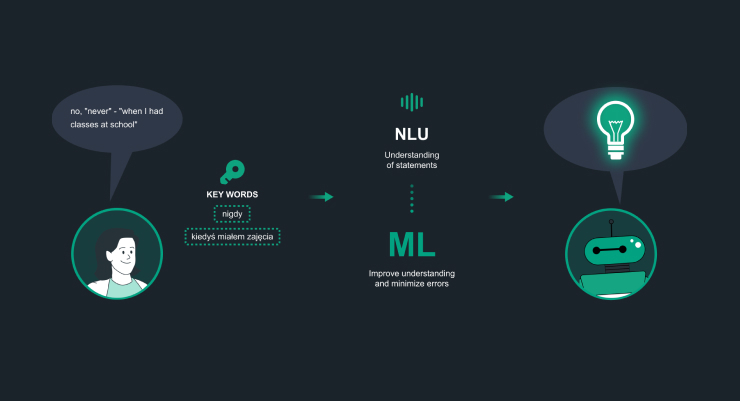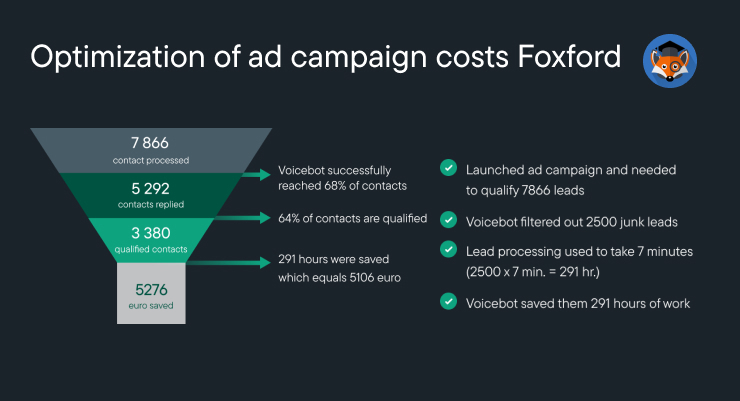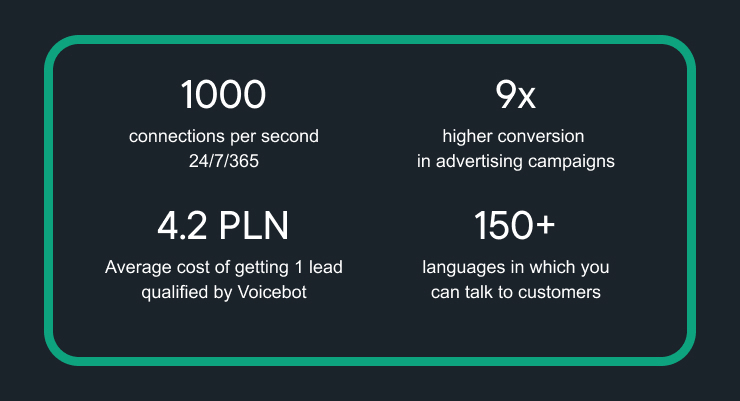AI in marketing: how voicebots help optimize ad campaigns
When campaign costs rise instead of conversions, it's time to reach for conversational technologies. Learn how voice bots help optimize massive paid campaigns and deliver personalized offers. Find out that voicebots are also extremely effective in increasing conversions and scaling campaigns. Discover the potential of these tools in marketing and sales.
Although today we associate voicebots mainly with devices like Alexa or Siri, they have broad applications in business. Tools using conversational technologies, such as voice bots, provide a new quality and even greater effectiveness to marketing efforts. With automation using Voicebots, mass advertising campaigns can be optimized and offers better personalized, resulting in increased conversions. Using voicebots, companies can achieve more in less time and for less money, which is extremely important in the current business environment.
What are voicebots and how do they work?
Voicebot is a special type of artificial intelligence tool, as it allows to interact with users and recognizes their intentions. Voicebots can be used to send personalized messages and notifications to customers, promoting products and services. They can also automate the process of prequalifying leads that flow into a campaign, or collect data on customer preferences, helping companies customize marketing strategies.
Voicebot, or virtual voice assistant, uses natural language understanding (NLU) and machine learning (ML) algorithms to interact with customers through voice commands. With NLU, bots are able to recognize and interpret users' verbal commands or questions, even if they are not spoken directly. Machine learning, on the other hand, makes them learn to process queries better and better based on their experience with customers.

We will explain this using the example of a voicebot for lead qualification, which we created to handle an advertising campaign for Foxford language school. The campaign was run on the client's Facebook advertising account. Users could fill out a form, from which the data was fed into our platform. Voicebot contacted within a minute after submitting the form and pre-qualified the user for a group (asking about the level of proficiency and preferred dates, among other things). Voicebot asked the question, "How long have you been learning English?" There are many ways to answer such a question ("3 years", "never", "well, I used to have classes at school"). Voicebot can recognize most of these statements by keywords and assign them to a specific category defined in the scenario (beginner course, intermediate course, etc.). It is this ability to understand even colloquial speech and respond in an appropriate manner that makes the interaction with the bot natural and similar to a conversation with another human being. As can be seen from this example, conversational artificial intelligence makes automation more human and friendly.

How did voicebot save nearly 24,000?
The best benefits of voicebot can be seen in the optimization processes of advertising campaigns. Let's go back to our language school. The influx of requests was so high that Foxford needed a tool to qualify the leads (to sift out the junk and assign users to groups), as well as analyze them, since it did not have a CRM system.
As a result of the advertising campaign, the company acquired 7866 leads. After using Apifonica's voicebot, it found that 2,500 of them, or 31.7 percent of the total sales funnel, were of poor quality. Taking into account the fact that salespeople earn an average gross salary of 13.8 thousand zlotys (data according to the 11th edition of Antal's salary report), i.e. 82.14 zlotys per hour, and that the time saved on each lead is 7 minutes, by using the voicebot, Foxford saved 291 hours of salespeople's work, or a sum of 23,919 zlotys.
How did voicebot increase the number of leads by 4 times?
Another example. Weegree is a blue-collar staffing agency with clients in Belgium, the Netherlands, Germany and Poland. The company needed a quick solution to integrate Facebook Ads into its own system and effectively scale campaigns. To do so, we created Voicebot, which automated the lead qualification process. This enabled the company to process more inquiries faster, and the number of leads processed by the bot increased 4-fold (to 34185) within a year of implementation. The automation also freed managers from routine work in favor of other more creative tasks and avoided hiring new people.
Voicebots, and optimizing ad campaigns
So let's recap, how can voicebots help optimize marketing campaigns and increase ROI?
Optimize campaign costs
By pre-filtering leads and eliminating unnecessary ones, saving time and reducing campaign handling expenses. What's more, with the ability to process more than 10,000 leads in just 2 minutes, voicebot allows you to cover any number of audiences without hiring additional staff.
Increase conversions
Voicebot responds to each lead 24/7, as soon as the inquiry is received, increasing the chance of a sale. Voicebot is able to process up to 10,000 calls in 2 minutes, allowing for faster responses and increased conversion rates.
Scaling the campaign
It allows scaling campaigns without hiring new employees. A Sales employee can make roughly 40-50 calls per day. This limits the number of leads that can be reprocessed immediately after a contact and can make it difficult to scale an advertising campaign. You can certainly hire more people to make calls, but this requires additional
Personalization of communication
Virtual voice assistants can also help tailor content to different users based on their preferences, purchase history and other data. Voicebot can respond to triggers in the CRM and deliver personalized offers to different audience segments based on specific criteria, such as customer value or previous purchases.

To get the most out of voice assistants, it is essential to test and refine voice-based campaigns using A/B testing and other proven strategies. With the right approach, voicebots can be a valuable tool for marketers to add a new level of personalization, save time and money, and ultimately improve ROI.
How to measure the success of a campaign using voicebot?
The success of a campaign using a voicebot can be measured by various indicators, the most important of course will be the costs and time saved thanks to automation. In addition, we can analyze the conversion rate (how many people decided to make a purchase after interacting with the voicebot) and the engagement rate (how many people started the conversation, how many successfully completed it) and compare the results with a campaign without the voicebot. Other metrics you can consider are the length of each interaction, the number of unique users and the number of repeated interactions over time. It's also worth checking uncompleted calls or failed and under-targeted interactions (no purchase) to analyze what the reasons were and modify the scenario or retrain the model.
Voicebots are a great tool to effectively optimize advertising campaigns, reduce costs and save time. By using conversational AI, voicebots can help you reach customers in a more personal and engaging way, and do so instantly and around the clock. Whether you want to personalize an offer, increase conversions, or collect important data to qualify leads, voicebots achieve these goals more efficiently and effectively. So, if voicebots haven't been part of your marketing strategy so far, maybe it's time to give them a voice?